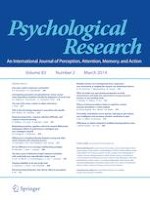02-04-2018 | Original Article
The role of the action context in object affordance
Gepubliceerd in: Psychological Research | Uitgave 2/2019
Log in om toegang te krijgenAbstract
Behavioral and neuroscience studies have shown that observation of objects automatically evokes potential actions to interact with those objects. In this study, the left and right hand key presses were facilitated when they corresponded with the task-irrelevant handle orientation of household objects, which is termed the affordance effect. The present study investigated how the affordance effect is affected by the action context when other agents are observed acting on a neutral or dangerous object. Participants were shown a series of pictures in which an actor grasped a neutral or dangerous object and moved it away from or toward the participant. The participants were required to press different keys to identify a symbol which was presented above the last picture. The results showed that affordance effect of a neutral object was modulated by the direction of object movement. When the neutral object moved away from the participant, an affordance effect was observed if the perceived action was congruent with handle orientation, whereas the affordance effect emerged if the perceived action was incongruent with handle orientation when the object was moved toward the participant. However, for the dangerous object, the affordance effect was obtained regardless of object movement direction or congruency between perceived action and handle orientation. This result suggests that the processing of objects involves a sophisticated integration of body behavior with the object.
